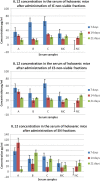Immunomodulatory effect of non-viable components of probiotic culture stimulated with heat-inactivated Escherichia coli and Bacillus cereus on holoxenic mice
- PMID: 25317114
- PMCID: PMC4172693
- DOI: 10.3402/mehd.v25.23239
Immunomodulatory effect of non-viable components of probiotic culture stimulated with heat-inactivated Escherichia coli and Bacillus cereus on holoxenic mice
Abstract
Background: Competition of probiotic bacteria with other species from the intestinal microbiota involves different mechanisms that occur regardless of probiotics' viability. The objective of this paper was to assess the cytokine serum levels in holoxenic mice after oral administration of non-viable components (NVC) of Enterococcus faecium probiotic culture stimulated with heat-inactivated Escherichia coli and Bacillus cereus in comparison to NVC of unstimulated E. faecium probiotic culture.
Methods: Probiotic E. faecium CMGb 16 culture, grown in the presence of heat-inactivated cultures of E. coli and B. cereus CMGB 102, was subsequently separated into supernatant (SN) and heat-inactivated cellular sediment (CS) fractions by centrifugation. Each NVC was orally administered to holoxenic mice (balb C mouse strain), in three doses, given at 24 hours. Blood samples were collected from the retinal artery, at 7, 14, and 21 days after the first administration of the NVC. The serum concentrations of IL-12 and tumor necrosis factor-alpha (TNF-α) interleukins were assessed by ELISA method.
Results: After the oral administration of SN component obtained from the probiotic culture stimulated with heat-inactivated cultures of B. cereus CMGB 102 and E. coli O28, the serum concentrations of IL-12 were maintained higher in the samples collected at 7 and 14 days post-administration. No specific TNF-α profile could be established, depending on stimulated or non-stimulated probiotic culture, NVC fraction, or harvesting time.
Conclusion: The obtained results demonstrate that non-viable fractions of probiotic bacteria, stimulated by other bacterial species, could induce immunostimulatory effects mediated by cytokines and act, therefore, as immunological adjuvants.
Keywords: Enterococcus faecium; immunomodulation; interleukins; intestinal microbiota; non-viable components; probiotic.
Figures


Similar articles
-
Modulation of virulence and antibiotic susceptibility of enteropathogenic Escherichia coli strains by Enterococcus faecium probiotic strain culture fractions.Anaerobe. 2011 Dec;17(6):448-51. doi: 10.1016/j.anaerobe.2011.05.019. Epub 2011 Jun 23. Anaerobe. 2011. PMID: 21723403
-
The effect of heat-inactivated BBMN68 on immune regulation and gut microbiota in immunosuppressed mice and exploration of its immunomodulation postbiotic functional components.Int J Biol Macromol. 2025 Jun;311(Pt 3):143758. doi: 10.1016/j.ijbiomac.2025.143758. Epub 2025 Apr 30. Int J Biol Macromol. 2025. PMID: 40316116
-
Effects of the probiotic Enterococcus faecium NCIMB 10415 on selected lactic acid bacteria and enterobacteria in co-culture.Benef Microbes. 2015;6(3):345-52. doi: 10.3920/BM2014.0052. Benef Microbes. 2015. PMID: 25519527
-
A Tentative Study of the Effects of Heat-Inactivation of the Probiotic Strain Shewanella putrefaciens Ppd11 on Senegalese Sole (Solea senegalensis) Intestinal Microbiota and Immune Response.Microorganisms. 2021 Apr 12;9(4):808. doi: 10.3390/microorganisms9040808. Microorganisms. 2021. PMID: 33921253 Free PMC article.
-
The probiotic paradox: live and dead cells are biological response modifiers.Nutr Res Rev. 2010 Jun;23(1):37-46. doi: 10.1017/S0954422410000090. Epub 2010 Apr 20. Nutr Res Rev. 2010. PMID: 20403231 Review.
Cited by
-
Probiotics: Healthy bugs and nourishing elements of diet.J Int Soc Prev Community Dent. 2015 Mar-Apr;5(2):81-7. doi: 10.4103/2231-0762.155726. J Int Soc Prev Community Dent. 2015. PMID: 25992331 Free PMC article. Review.
-
Boletus edulis Extract-A New Modulator of Dysbiotic Microbiota.Life (Basel). 2023 Jun 30;13(7):1481. doi: 10.3390/life13071481. Life (Basel). 2023. PMID: 37511858 Free PMC article.
-
Lactobacillus rhamnosus GG soluble mediators ameliorate early life stress-induced visceral hypersensitivity and changes in spinal cord gene expression.Neuronal Signal. 2020 Nov 23;4(4):NS20200007. doi: 10.1042/NS20200007. eCollection 2020 Dec. Neuronal Signal. 2020. PMID: 33343931 Free PMC article.
-
Probiotic-Induced Tolerogenic Dendritic Cells: A Novel Therapy for Inflammatory Bowel Disease?Int J Mol Sci. 2021 Jul 31;22(15):8274. doi: 10.3390/ijms22158274. Int J Mol Sci. 2021. PMID: 34361038 Free PMC article. Review.
-
Probiotic based-diet effect on the immune response and induced stress in irradiated mass reared Ceratitis capitata males (Diptera: Tephritidae) destined for the release in the sterile insect technique programs.PLoS One. 2021 Sep 10;16(9):e0257097. doi: 10.1371/journal.pone.0257097. eCollection 2021. PLoS One. 2021. PMID: 34506561 Free PMC article.
References
-
- Adams CA. The probiotic paradox: live and dead cells are biological response modifiers. Nutr Res Rev. 2010;23:37–46. - PubMed
-
- Cocconier MH, Bernet MF, Kernéis S, Chauviére G, Fourniat J, Servin A. Inhibition of adhesion of enteroinvasive pathogens to human intestinal Caco-2 cells by Lactobacillus acidophilus strain LB decreases bacterial invasion. FEMS Microbiol Lett. 1993;110:299–306. - PubMed
-
- Lazar V. Quorum sensing in biofilms – how to destroy the bacterial citadels or their cohesion/power? Anaerobe. 2011;17:280–5. - PubMed
-
- Quadri LEN. Regulation of class II bacteriocin production by cell-cell signaling. J Microbiol. 2003;41:175–82.
-
- Moslehi Jenabian S, Gori K, Jespersen L. AI-2 signalling is induced by acidic shock in probiotic strains of Lactobacillus spp. Int J Food Microbiol. 2009;135:295–302. - PubMed
LinkOut - more resources
Full Text Sources
Other Literature Sources
